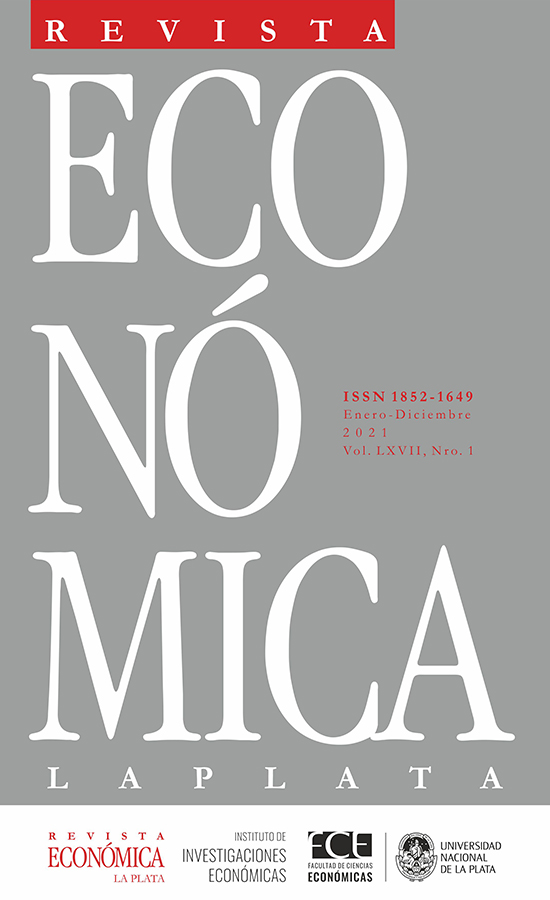Forecasting crop yields through climate variables using mixed frequency data. The case of Argentine soybeans
DOI:
https://doi.org/10.24215/18521649e022Palabras clave:
rendimiento, pronósticos, clima, frecuencias mixtas, sojaResumen
Este artículo evalúa el valor de utilizar información sobre variables climáticas publicadas con anticipación y con una frecuencia superior a la variable objetivo de interés -los rendimientos de los cultivos- con el fin de obtener pronósticos a corto plazo. Se utilizan datos climáticos agregados y desagregados, esquemas de ponderación alternativos y diferentes esquemas de actualización para evaluar el desempeño de las predicciones. Este estudio se centra en el caso de los rendimientos de la soja en Argentina. Los resultados muestran que los modelos que incluyen datos meteorológicos de alta frecuencia obtuvieron mejores resultados, particularmente durante las tres campañas consecutivas después de 2008/09, cuando el rendimiento de la soja disminuyó en casi un 50%. A su vez, las combinaciones de pronóstico mostraron un mejor desempeño que los modelos de pronóstico individuales.
Referencias
Andreou, E., Ghysels, E., & Kourtellos, A. (2013). Should macroeconomic forecasters use daily financial data and how? Journal of Business & Economic Statistics 31(2), 240–251.
Auffhammer, M., V. Ramanathan, & J. R. Vincent (2012). Climate change, the monsoon, and rice yield in India. Climatic Change 111(2), 411–424.
Clark, T. E., & McCracken, M. W. (2010). Averaging forecasts from VARs with uncertain instabilities. Journal of Applied Econometrics 25(1), 5–29.
Ghysels, E., Santa-Clara, P. & Valkanov, R. (2004). The MIDAS touch: Mixed data sampling regression models. University of North Carolina and UCLA Discussion Paper..
Ghysels, E., Santa-Clara, P., & Valkanov, R. (2006). Predicting volatility: getting the most out of return data sampled at different frequencies. Journal of Econometrics 131(1-2), 59–95.
Giacomini, R. & Rossi, B. (2010). Forecast comparisons in unstable environments. Journal of Applied Econometrics 25(4), 595–620.
Hendry, D. F. & Clements, M. P. (2004). Pooling of forecasts. The Econometrics Journal 7(1), 1–31.
Jansen, W. J., Jin, X. & de Winter, J. M. (2016). Forecasting and nowcasting real GDP: comparing statistical models and subjective forecasts. International Journal of Forecasting 32(2), 411–436.
Lobell, D. B. & Burke, M. B. (2009). Climate change and food security: adapting agriculture to a warmer world, Volume 37. Springer Science & Business Media.
Lobell, D. B. & Burke, M. B. (2010). On the use of statistical models to predict crop yield responses to climate change. Agricultural and Forest Meteorology 150, 1443–1452.
Lobell, D. B., Cahill, K. N. & Field, C. B. (2007). Historical effects of temperature and precipitation on California crop yields. Climatic Change 81, 187–203.
Makridakis, S., Spiliotis, E. & Assimakopoulos, V. (2018). The M4 competition: Results, findings, conclusion and way forward. International Journal of Forecasting 34, 802–808.
Marcellino, M. (2002). Forecasting pooling for short time series of macroeconomic variables. Oxford Bulletin of Economics and Statistics 66, 91–112.
Ray, D. K., Gerber, J. S., MacDonald, G. K. & West, P. C. (2015). Climate variation explains a third of global crop yield variability. Nature Communications 6, 5989.
Reilly, J. & Schimmelpfennig, D. (2000). Irreversibility, uncertainty, and learning: portraits of adaptation to long-term climate change. Climatic Change 45(1), 253–278.
Schlenker, W. & Lobell, D. B. (2010). Robust negative impacts of climate change on african agriculture. Environmental Research Letters 5(1), 014010.
Schlenker, W. & Roberts, M. J. (2009). Nonlinear temperature effects indicate severe damages to us crop yields under climate change. Proceedings of the National Academy of Sciences 106(37), 15594–15598.
Tibshirani, R. (1996). Regression shrinkage and selection via the lasso. Journal of the Royal Statistical Society: Series B (Methodological) 58(1), 267–288.
Timmermann, A. (2006). Forecast Combinations. North Holland.
Welch, J. R., Vincent, J. R., Auffhammer, M., Moya, P. F., Dobermann, A., & Dawe, D. (2010). Rice yields in tropical/subtropical Asia exhibit large but opposing sensitivities to minimum and maximum temperatures. Proceedings of the National Academy of Sciences 107(33), 14562–14567.
Wheeler, T. R., Craufurd, P. Q., Ellis, R. H., Porter, J. R., & Prasad, P. V. (2000). Temperature variability and the yield of annual crops. Agriculture, Ecosystems & Environment 82(1-3), 159–167.
Descargas
Publicado
Número
Sección
Licencia
El material publicado en la revista se distribuye bajo una licencia de Creative Commons de Atribución-NoComercial-SinDerivadas 4.0 Internacional (CC BY-NC-ND 4.0). Esta licencia obliga dar crédito de manera adecuada, brindar un enlace a la licencia, e indicar si se han realizado cambios; no permite hacer uso comercial de la obra; y si se remezclara, transformara o creara otro material a partir de la obra, no permite distribuir esa modificación.



































